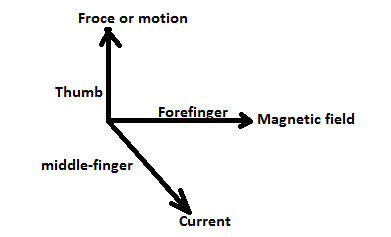
Name and state the law which is used to determine the direction of force on a current carrying conductor placed in a magnetic field.
Answer
556.2k+ views
Hint: When a current carrying conductor is placed in a magnetic field then due to the change in the flux the conductor will experience a force and the direction of force experienced by current carrying conductor placed in an external magnetic field will be given by The Fleming's left-hand rule.
Complete answer:
Fleming's left-hand rule:
Statement: Fleming's left-hand rule states that “When a current-carrying conductor is placed in an external magnetic field, the conductor experiences a force perpendicular to both the external magnetic field and to the direction of the current flow.”
Fleming's left-hand rule was invented by the English electrical engineer and physicist John Ambrose Fleming in the late 19th century.
Fleming's left-hand rule can also be used to determine the direction of any of the three quantities magnetic force on the conductor, magnetic field and the current. To perform that we will do as following,
Hold your left hand such that the thumb, fore-finger and middle-finger are held mutually perpendicular to each other. Now each of the three fingers will represent the three quantities. The fore-finger will represent the direction of the magnetic Field, the middle-finger will represent the direction of the Current and the thumb will represent the direction of Motion that is due to the force acting on the conductor. Hence the motion of the conductor is due to the force on the conductor and the direction of the motion of the conductor is represented by thumb. So, the direction of force on a current carrying conductor placed in a magnetic field will be given by the thumb.

Note:
Like Fleming's left-hand rule there is another rule called Fleming's left right-hand rule. The difference between both of them is that Fleming's left-hand rule is used for electric motors, while Fleming's right-hand rule is used for electric generators. In a typical electric motor, the electric current and magnetic field exist and these two are the causes, and they lead to the force that creates the motion which is the effect, so the left-hand rule is used for motors. In an electric generator, the motion and magnetic field exist as these two are the causes and they lead to the creation of the electric current which is the effect, so the right-hand rule is used for generators.
Complete answer:
Fleming's left-hand rule:
Statement: Fleming's left-hand rule states that “When a current-carrying conductor is placed in an external magnetic field, the conductor experiences a force perpendicular to both the external magnetic field and to the direction of the current flow.”
Fleming's left-hand rule was invented by the English electrical engineer and physicist John Ambrose Fleming in the late 19th century.
Fleming's left-hand rule can also be used to determine the direction of any of the three quantities magnetic force on the conductor, magnetic field and the current. To perform that we will do as following,
Hold your left hand such that the thumb, fore-finger and middle-finger are held mutually perpendicular to each other. Now each of the three fingers will represent the three quantities. The fore-finger will represent the direction of the magnetic Field, the middle-finger will represent the direction of the Current and the thumb will represent the direction of Motion that is due to the force acting on the conductor. Hence the motion of the conductor is due to the force on the conductor and the direction of the motion of the conductor is represented by thumb. So, the direction of force on a current carrying conductor placed in a magnetic field will be given by the thumb.

Note:
Like Fleming's left-hand rule there is another rule called Fleming's left right-hand rule. The difference between both of them is that Fleming's left-hand rule is used for electric motors, while Fleming's right-hand rule is used for electric generators. In a typical electric motor, the electric current and magnetic field exist and these two are the causes, and they lead to the force that creates the motion which is the effect, so the left-hand rule is used for motors. In an electric generator, the motion and magnetic field exist as these two are the causes and they lead to the creation of the electric current which is the effect, so the right-hand rule is used for generators.
Recently Updated Pages
Master Class 11 Economics: Engaging Questions & Answers for Success

Master Class 11 English: Engaging Questions & Answers for Success

Master Class 11 Social Science: Engaging Questions & Answers for Success

Master Class 11 Biology: Engaging Questions & Answers for Success

Class 11 Question and Answer - Your Ultimate Solutions Guide

Master Class 11 Business Studies: Engaging Questions & Answers for Success

Trending doubts
What is meant by exothermic and endothermic reactions class 11 chemistry CBSE

10 examples of friction in our daily life

One Metric ton is equal to kg A 10000 B 1000 C 100 class 11 physics CBSE

Difference Between Prokaryotic Cells and Eukaryotic Cells

What are Quantum numbers Explain the quantum number class 11 chemistry CBSE

1 Quintal is equal to a 110 kg b 10 kg c 100kg d 1000 class 11 physics CBSE




